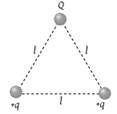How much kinetic energy will be gained by an – particle in going from a point at 70 V to another point at 50 V ?
(1)
(2)
(3)
(4)
70V पर स्थित बिंदु से 50V पर स्थित दूसरे बिंदु तक जाने में एक –कण कितनी गतिज ऊर्जा प्राप्त कर लेगा?
(1)
(2)
(3)
(4)
Find equivalent capacitance between and if each capacitor is .
1.
2.
3.
4.
यदि प्रत्येक संधारित्र है, तब और के मध्य तुल्य धारिता ज्ञात कीजिए -
1.
2.
3.
4.
The potential at a certain point in an electric field is 200 V. The work done in carrying an electron upto that point will be.
1.
2.
3.
4.
विद्युत क्षेत्र में एक निश्चित बिंदु पर विभव 200 V है। उस बिंदु तक एक इलेक्ट्रॉन को ले जाने में किया गया कार्य कितना होगा -
1.
2.
3.
4.
The displacement of a charge Q in the electric field is . The work done is
(1)
(2)
(3)
(4)
एक आवेश Q का विद्युत क्षेत्र में विस्थापन है। किया गया कार्य ज्ञात कीजिए-
(1)
(2)
(3)
(4)
Electric potential at any point is , then the magnitude of the electric field is
(1)
(2)
(3)
(4) 7
किसी भी बिंदु पर विद्युत विभव है, तब विद्युत क्षेत्र का परिमाण है:
(1)
(2)
(3)
(4) 7
Three charges Q, (+q) and (+q) are placed at the vertices of an equilateral triangle of side l as shown in the figure. If the net electrostatic energy of the system is zero, then Q is equal to

(1)
(2) (–q)
(3) (+q)
(4) Zero
l भुजा के एक समबाहु त्रिभुज के शीर्ष पर तीन आवेश Q, (+q) और (+q) रखे गए हैं जैसा कि आकृति में दर्शाया गया है। यदि निकाय की कुल स्थिरवैद्युत ऊर्जा शून्य है, तो Q किसके बराबर है?

(1)
(2) (–q)
(3) (+q)
(4) शून्य
A proton is about 1840 times heavier than an electron. When it is accelerated by a potential difference of 1 kV, its kinetic energy will be -
(1) 1840 keV
(2) 1/1840 keV
(3) 1 keV
(4) 920 keV
एक प्रोटॉन एक इलेक्ट्रॉन की तुलना में लगभग 1840 गुना भारी है। जब इसे 1 kV के विभवांतर से त्वरित किया जाता है, तो इसकी गतिज ऊर्जा होगी -
(1) 1840keV
(2) 1/1840keV
(3) 1 keV
(4) 920 keV
A parallel plate condenser has a capacitance 50 μF in air and 110 μF when immersed in an oil. The dielectric constant ‘k’ of the oil is
(1) 0.45
(2) 0.55
(3) 1.10
(4) 2.20
एक समांतर प्लेट संधारित्र की वायु में धारिता 50 μF है और यह 110 μF जब वह तेल में डूबा होता है। तेल का परावैद्युत स्थिरांक 'k' है-
(1) 0.45
(2) 0.55
(3) 1.10
(4) 2.20
The distance between charges 5 × 10–11 C and –2.7 × 10–11 C is 0.2 m. The distance at which a third charge should be placed in order that it will not experience any force along the line joining the two charges is
(1) 0.44 m
(2) 0.65 m
(3) 0.556 m
(4) 0.350 m
5 × 10–11 C और –2.7 × 10–11 C आवेशों के बीच की दूरी 0.2 m है। वह दूरी जिस पर एक तीसरा आवेश इस क्रम में रखा जाना चाहिए कि वह दो आवेशों को जोड़ने वाली रेखा की दिशा में किसी भी बल का अनुभव नहीं करेगा, है-
(1) 0.44m
(2) 0.65m
(3) 0.556m
(4) 0.350m
The dielectric constant k of an insulator cannot be
(1) 3
(2) 6
(3) 8
(4) ∞
एक कुचालक का परावैद्युतांक k नहीं हो सकता है:
(1) 3
(2) 6
(3) 8
(4) ∞








